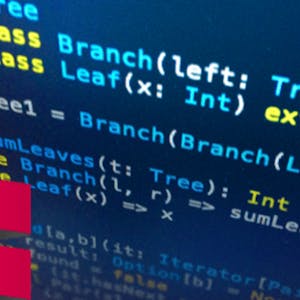Big Data Analysis with Scala and Spark (Scala 2 version)
Manipulating big data distributed over a cluster using functional concepts is rampant in industry, and is arguably one of the first widespread industrial uses of functional ideas. This is evidenced by the popularity of MapReduce and Hadoop, and most recently Apache Spark, a fast, in-memory distributed collections framework written in Scala. In this course, we’ll see how the data parallel paradigm can be extended to the distributed case, using Spark throughout. We’ll cover Spark’s programming model in detail, being careful to understand how and when it differs from familiar programming models, like shared-memory parallel collections or sequential Scala collections. Through hands-on examples in Spark and Scala, we’ll learn when important issues related to distribution like latency and network communication should be considered and how they can be addressed effectively for improved performance.Learning Outcomes. By the end of this course you will be able to:
- read data from persistent storage and load it into Apache Spark,
- manipulate data with Spark and Scala,
- express algorithms for data analysis in a functional style,
- recognize how to avoid shuffles and recomputation in Spark,
Recommended background: You should have at least one year programming experience. Proficiency with Java or C# is ideal, but experience with other languages such as C/C++, Python, Javascript or Ruby is also sufficient. You should have some familiarity using the command line. This course is intended to be taken after Parallel Programming: https://www.coursera.org/learn/parprog1
.
Note that this version of the course uses Scala 2.13. You can find a more recent version of the course that uses Scala 3 here: https://www.coursera.org/learn/scala-spark-big-data
None
Syllabus
Syllabus - What you will learn from this course
Week 1
Getting Started + Spark Basics
Week 2
Reduction Operations & Distributed Key-Value Pairs
Week 3
Partitioning and Shuffling
Week 4
Structured data: SQL, Dataframes, and Datasets
FAQ
When will I have access to the lectures and assignments?
Access to lectures and assignments depends on your type of enrollment. If you take a course in audit mode, you will be able to see most course materials for free. To access graded assignments and to earn a Certificate, you will need to purchase the Certificate experience, during or after your audit. If you don't see the audit option:
What will I get if I purchase the Certificate?
When you purchase a Certificate you get access to all course materials, including graded assignments. Upon completing the course, your electronic Certificate will be added to your Accomplishments page - from there, you can print your Certificate or add it to your LinkedIn profile. If you only want to read and view the course content, you can audit the course for free.
Is financial aid available?
Yes. In select learning programs, you can apply for financial aid or a scholarship if you can’t afford the enrollment fee. If fin aid or scholarship is available for your learning program selection, you’ll find a link to apply on the description page.
Reviews
